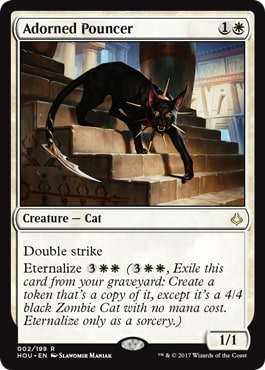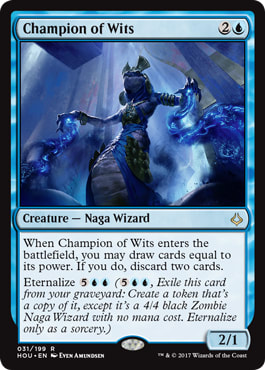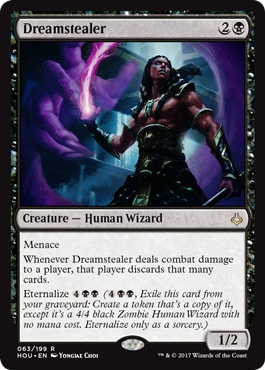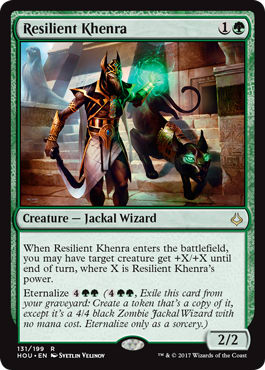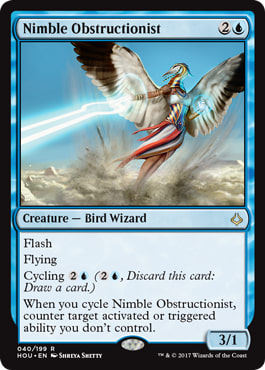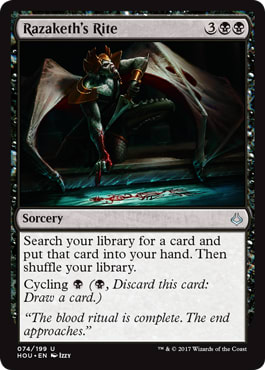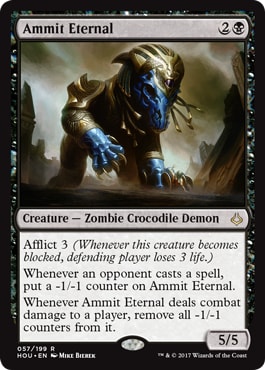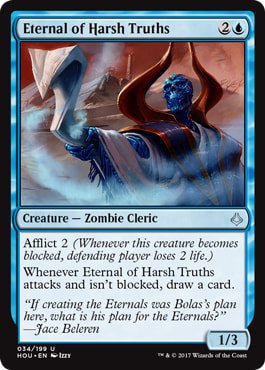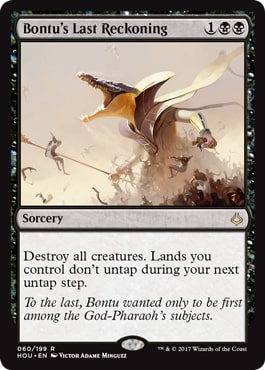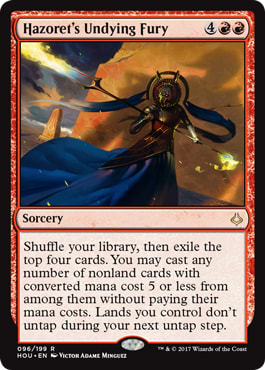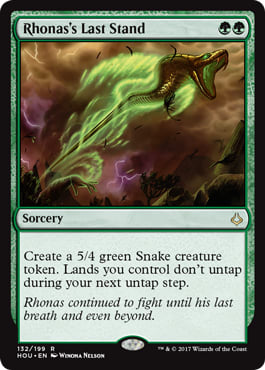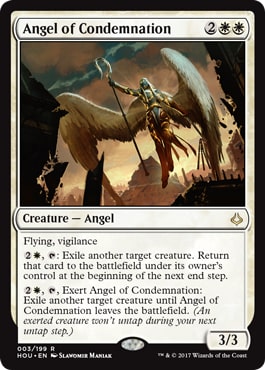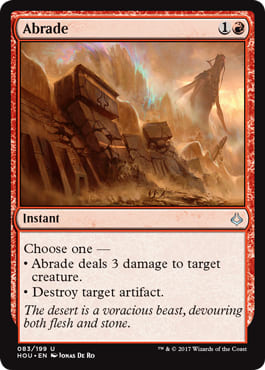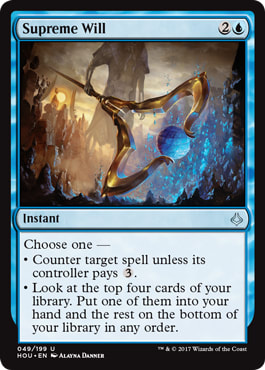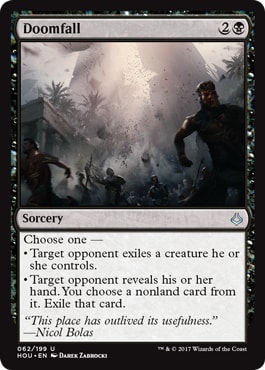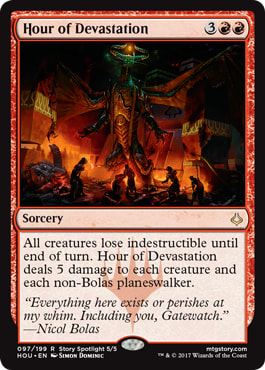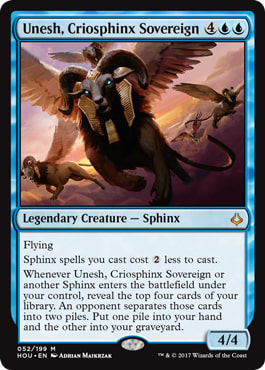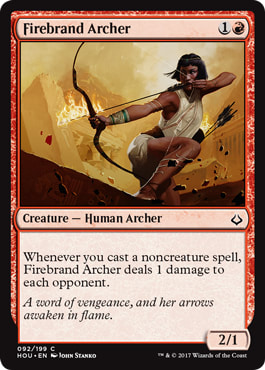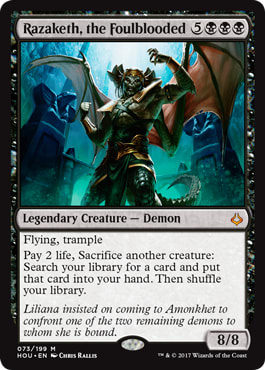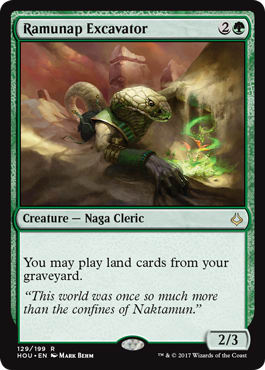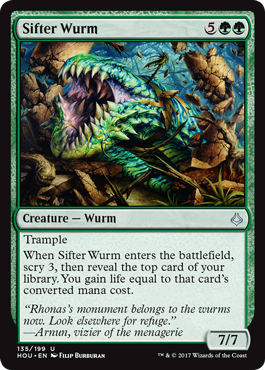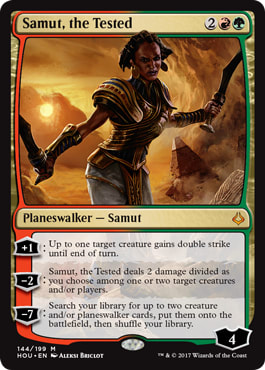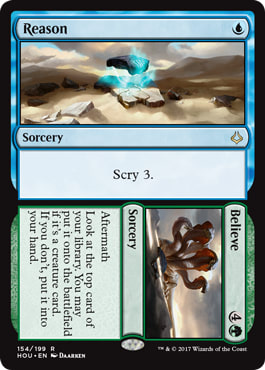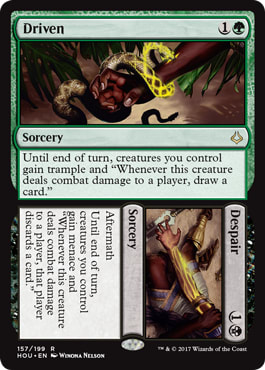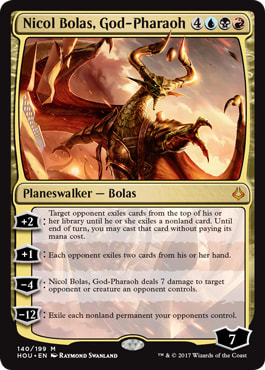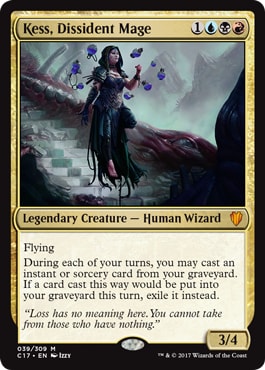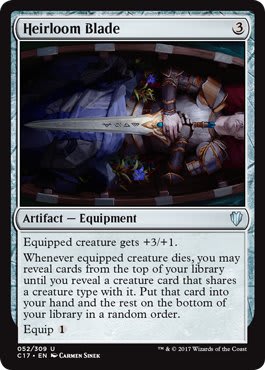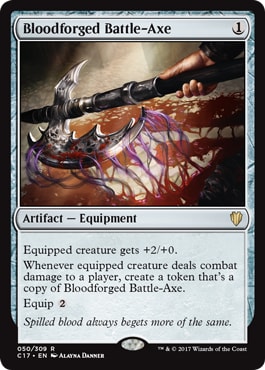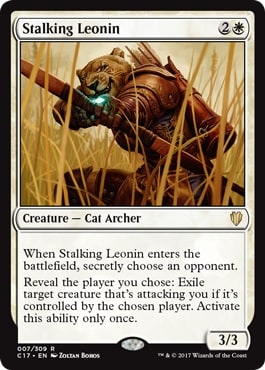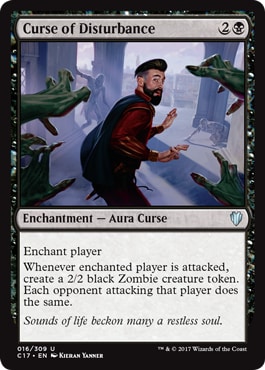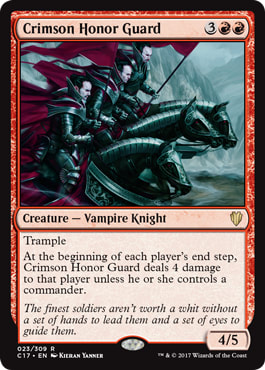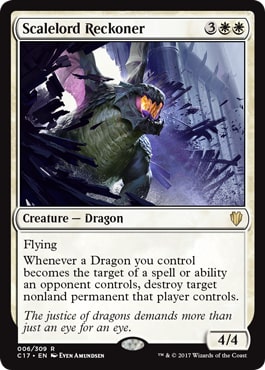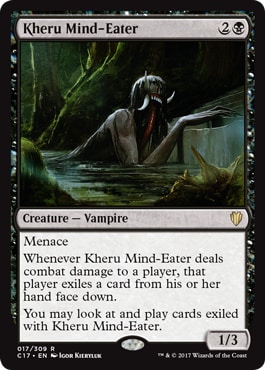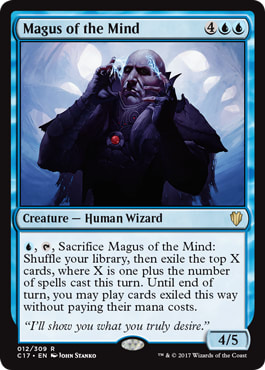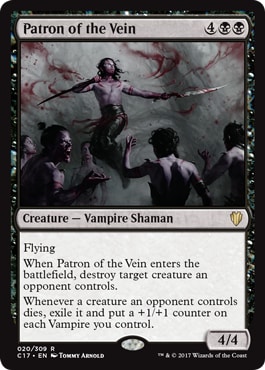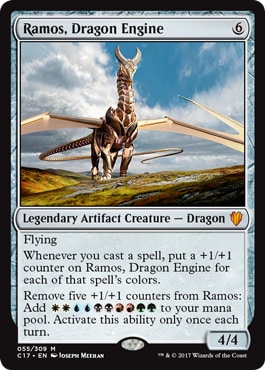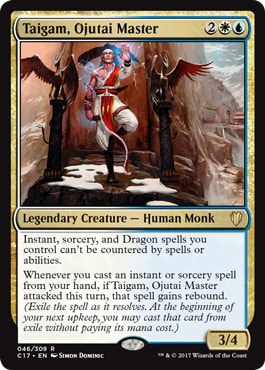The Hour of Devastation is upon us, and although it doesn't bring nearly as much for Cube as Amonkhet, even on a pound-for-pound rate, that isn't completely unexpected considering how bonkers Amonkhet was for Cubes.
That said, the set still brings us some solid options for consideration for our Cubes, and with Commander 2017 coming around the corner, it's a good time to look into how this set shapes up for Cube.
Of note: Although this set review has been released after Pro Tour Hour of Devastation and Grand Prix Minneapolis, know that these evaluations are based on actual play in my Cube and not merely outsourced to playing at these events. If I'm saying a card has been working well based on my experience, it's based on actual experience from trying them out in my Cube and finding the cards actually have been working well in my Cube.
As usual, I'll break this down by mechanic.
Eternalize
There was an M-files article showing how the cards' costs got pushed down to push them for constructed. Although, as we've sometimes seen, that doesn't necessarily make them Cubeworthy. Like Flashback and Embalm, Eternalize rewards attrition and going for the long game, but it also tends to give some backup for decks that aren't planning for the long game as mana flood insurance or ways to get another threat in the late game. I've frequently made comparisons to cards like Chainer's Edict and Burst Lightning, cards that are mainstays in Cube even if their individual modes can be inefficient — sometimes Chainer's Edict is just a Cruel Edict, but having the option, even for aggressive decks is nice (although an aggro deck generally prefers something like Diabolic Edict over Chainer's Edict.
As the first Eternalize reveal, Adorned Pouncer was the card that got the most attention for Cube initially as a decent on-rate beater in a slot for White aggro decks that isn't really well represented — 2-drops.
The obvious analog is Fencing Ace and the recently-pauper shifted Viashino Slaughtermaster (which is just fine in Red.) Similar to cards like Fencing Ace, Adorned Pouncer is much better if the deck playing it has access to buffing effects like equipment, Elspeth, Knight-Errant and anthems, but found that these supporters weren't integral to the card being played.
All of the Eternalize cards had a benefit where the opponent was hesitant to kill them versus other things because it could eternalize — and while it does pretty much tap you out to do so, I've found that the opponent has to either deal with a 4/4 double striker or lose quickly. That being said, there are plenty of times that it's just a 1/1 double striker since there may be times when there isn't time to eternalize it, but I've found it worked pretty well in White aggro decks.
There aren't really a lot of absurd White 2-drops outside of Stoneforge Mystic (assuming a critical mass of support) and Anafenza, Kin-Tree Spirit. Adorned Pouncer isn't a S-tier White 2-drop like those, but it's a nice option to bolster White aggro decks.
Earthshaker Khenra is a card that seems to have been underrated, but I've found that it's a fantastic add for Red attacking decks as a 2-drop hasty beater and the best Eternalize card. While it's true that Red aggressive decks typically don't want to get to where they're casting 6-drops, Earthshaker Khenra has provides a nice plan B for aggressive decks, especially as a nice way to break serve after a wrath effect or playing a blocker like a Batterskull. Even without taking Eternalize into effect, I've found it isn't hard to clear a small blocker or value creature out of the way and attack the opponent for two. It's true that there have been a few 2/Xs for 2 with haste and they aren't really seeing play as creatures have been getting better (Speedway Fanatic sees barely any Cube play) but I've found that Earthshaker Khenra helps to win in the late game — and it could be because it has haste, but I've found it to be eternalized more than other creatures — and having that option is nice against decks that look to block with beast tokens and baloth-sized creatures. Red's 2-drops have served the color better than White's; but, even with that being said, it's a great addition for Red aggro decks in Cube.
The rest of the eternalize cards aren't as good for cube, but are at least worth a look.
Champion of Wits is nice as a take on cards like Frantic Search (without untapping the lands.) It gives no real card advantage until it’s eternalized but can get absurd when it finally does. I found this didn't happen long (even though it does reward decks for going long, which most Blue decks intend to do.) Eternalizing this is no joke, but Blue creatures can be hard to find room for in many Cubes. Because of this, my impressions were that it's a middle-of-the-road tier 3-drop Blue creature — it's likely not better in Cube than something like Trinket Mage, especially if power and other fast mana's in the mix.
Dreamstealer is a take on Hypnotic Specter as a saboteur with some form of evasion; it has the best upside of being equipped/having a power boost but found it was extremely clunky if it didn't have that (and in some decks like Golgari midrange, they weren't in the market for a lot of buffs anyway.) It can be eternalized and force the opponent to deal with it or have their hand shredded, but it was just too expensive and I found it was too low impact to compete with Black 3-drops, especially since there's arguably a better take on this in Commander 2017.
Resilient Khenra is a bit too low-impact and only really for aggro decks since it requires something to buff and its body is pretty lackluster.
Cycling
Although there are some great solid cyclers (Striped Riverwinder, Rampaging Hippo) for Pauper Cube, there really isn't much here for Cubes outside of that rarity.
Nimble Obstructionist suffered from unfair comparisons to Vendilion Clique as a 3/1 flash flier and was thus dismissed. Obviously, this isn't Vendilion Clique, but simply not being Vendilion Clique misses out on a quality Cube card.
Stifle has been described as the duct tape, as something that can cheaply deal with a myriad of things but isn't the most effective at doing them; cards like fetchlands are stopped by Stifle and stopping an individual equip can be great, but usually isn't enough for a deck, making it see little Cube play. Disallow also usually never acted as a Stifle either, as it usually just countered the spell. So why do I like this one?
Nimble Obstructionist has a few failsafes for getting out of being a dead card by being a 3/1 flash flier for ![]()
![]() and being able to be cycled away if need be. This combination has allowed it to be a solid card in the maindeck as a way to pressure Planeswalkers and to even act as a way to prevent an opponent from ultimating a planeswalker when doing so would kill the Planeswalker. In its time, I haven't seen it used for stifling that often, but it's been great when it has, and it's overall been solid (better than Champion of Wits.)
and being able to be cycled away if need be. This combination has allowed it to be a solid card in the maindeck as a way to pressure Planeswalkers and to even act as a way to prevent an opponent from ultimating a planeswalker when doing so would kill the Planeswalker. In its time, I haven't seen it used for stifling that often, but it's been great when it has, and it's overall been solid (better than Champion of Wits.)
Razaketh's Rite — In the Amonkhet cube review, I talked about how some of the better cyclers like Censor and Curator of Mysteries, both of which cycled for a single mana, had a nice other use that worked well in most Cube decks by being effective tools for those decks on top of being a cantrip.
Unfortunately, the Rite mode was almost always to cycle it since the retail cost was so high.
Afflict
Afflict's creatures are mostly weak. Not a “bad mechanic” but it's represented poorly as the cards themselves just aren't that good.
Ammit Eternal is the best of Afflict's cards as it hits like a truck and, like Phyrexian Negator, punishes players who durdle around without being a terrible card in niche scenarios. Like other saboteur creatures, it doesn't have evasion but it does incentivize making it so that the opponent doesn't block. It getting smaller from spells was awkward, but not enough to make this a bad card, but I didn't find it to be a staple or anything like that.
Many other Afflict cards don't really utilize the mechanic well enough to be worth it, as they disincentivize blocking, but aren't really strong enough on their own to make you, to put it bluntly, really care.
Eternal of Harsh Truths is a good example of this. It's another take on the Ophidian family of cards like Scroll Thief and, although having afflict can make the opponent think twice about having to block it or take 2, I've found it's also easy for the decks playing against it to just take it. It's easy to just ignore the life loss in some matches and, in a deck like Blue control, making the opponent lose life isn't really that big of a deal.
Blue tempo decks can utilize it as a somewhat evasive threat, but I've found these kinds of cards really need to pull their weight, and this doesn't.
Similarly, Wildfire Eternal can, in theory, put the opponent in an awkward situation where they have to block it or risk taking a lot of damage, but the average payoff isn't really that great since most Red Cube direct damage spells either deal 3 (or 4, sometimes) or are creature removal, making it act as a poor man's Ashling, the Extinguisher, which hasn't seen Cube play in nearly a decade and even taking those scenarios out of the question (if, say, there's card draw spells), it still isn't worth the potential payoffs. While it can also, in theory, create a tension where the opponent has to respect you having something, much like Champion of Rhonas, being able to make that gamble comes at the cost of having an incredibly inefficient creature.
Decks that utilize the cards in this cycle, like Bontu's Last Reckoning are typically those that utilize non-land mana sources, like mana rocks, so it's not hard for those decks to get around the drawback, but overall these haven't been received well nor performed that well.
Bontu's Last Reckoning is the best one. Obviously it's not Toxic Deluge, but that doesn't really mean much. Making it so that your lands don't untap makes it slightly easier for the opponent to break serve, but this isn't such a bad thing for letting the opponent possibly extend into another wrath. It's also possible to set it up so that you aren't as impacted by the drawback, either by tapping non-land sources or having other cards that can mow down what comes after and if cast in the late game, it may not matter that much.
Kefnet's Last Word is obviously no Control Magic, but can a second-rate one work?
I've found it to be pretty poor — it has some upsides of being able to steal artifacts and enchantments (but this hardly ever happened) but I usually found the tempo loss to be too large — stealing a threat meant that the opponent had to take their turn to deal with the fact that you stole their best thing and the drawback of Kefnet's Last Word increased the time by a turn, which was too much time, making it perform poorly.
Hazoret's Undying Fury isn't that great since it does a poor job of closing games out.
It looks like a Mind's Desire for 4, but Mind's Desire is just for one deck, storm, as the payoff is abysmal if you're not going all-in on that strategy. In theory, it's a super-charged Lava Axe where the deck doesn't care if they can't untap their lands since the opponent is just dead.
Because of that, the best hope for this kind of card is in a pure burn deck since getting Kari Zevs and Flametongue Kavus aren't going to end the game right after. This puts it into a very niche category; and, even then, it's not a great payoff card either.
Rhonas's Last Stand — as cliché as it sounds, even though it was powered out with mana elves to help get around the drawback, the 5/4 usually just died not long after, without making much of an impact. Having 4 toughness can help get around bolts and can help against Red decks packing a lot of bolts for removal, but it just played out rather poorly and Oketra's Last Mercy is just awful, as pure lifegain cards are.
Exert
Angel of Condemnation — 4-drops are competitive and Angel of Condemnation suffers because it isn't a curve topper or “deal with this or die now” threat like Hero of Bladehold.
The obvious analogue is Eldrazi Displacer, another White 3/3 that blinks things. It taps for use but I found Eldrazi Displacer usually just bottlenecked naturally at one or two activations due to requiring colorless mana, so the amount of times that they both were used was pretty similar.
Although it works incredibly well with blinking and as a way to remove some threats, I tried it out in my Cube and it didn't really compete all that well with other White 4-drops, so I did eventually cut it.
Miscellaneous
Riddleform – is in a weird spot for Cube as it's an unreliable blocker, making it act closer to something like Lava Spike and those types of cards as a pure damage source rather than a blocker.
This puts it into a weird slot where it's mainly wanted by a niche deck — a “spells matters” deck that wants a mostly-offensive card with some late-game potential due to being able to scry. This makes it difficult to justify in Cube.
The “choose one” cycle — meant to provide options for different stages of the game and one mode generally covers what the other doesn't. Supreme Will is a great example of this, as the ability to Impulse helps the card to not be a dead draw (although I've generally found cards like Mana Leak tend to keep their value longer than people think.)
Abrade has had some comparisons to Smash to Smithereens since both destroy artifacts and say “3 damage”, but comparing the role of the two is a false equivalency.
Reddit poster mykenae talked about how it's essentially Red's Disenchant, trading up the ability for dealing with enchantments with hitting a creature for 3, which is a big upgrade. There aren't a lot of pure comparisons other than Erase for pure enchantment removal and Strafe for the closest analogue in Red.
Smash to Smithereens is a purely offensive card that works on the Philosophy of Fire idea, providing both disruption and doing something that the deck wants to do — push forward momentum by dealing 3 to a player. While it's nice if it hits something extremely important, the artifact itself usually was collateral damage since it was pushing forward momentum, regardless of if it was hitting a Signet or a Batterskull. Because of this, Smash to Smithereens isn't that good in non-aggro Red decks since decks like Jund or Grixis control don't really care about the opponent's life total for most of the game.
Because of this, Abrade is a flexible tool that's extremely flexible removal source rather than being a blunt source of damage. That said, it's still fine card to play in Red aggressive decks since it deals with things that could stop your team, but I've found its rate of adoption is higher in non-aggro decks. Does this mean it's not Cubeworthy? Hardly, it's great — it may very well be the best card for Cube in this entire article. Go play it in your Cube (and don't just cut Smash to Smithereens, they play quite different roles, unless you really want to curtail artifact hate in your Cube.)
Supreme Will and Doomfall
These two ended up being too costly for what they did; and, although their varying modes helped the cards to cover different bases, although they were flexible, I found that they failed on what makes many flexible cards in cube fail — they don't really work efficiently in the role of what Cube decks want to do. After all, there's a reason that cards like To The Slaughter don't see Cube play but Chainer's Edict does (it costs 2) even if the flashback cost may not happen often.
The main issue was, at the end of the day, these cards were overcosted on their modes and they performed poorly.
Hour cycle
Hour of Devastation has the best hope for Cube.
Let's look at commonly used large creatures in the 450-card CubeTutor average:
5-toughness: Wall of Roots, Thundermaw Hellkite, Aetherling, Polukranos, World Eater, Avenger of Zendikar, Craterhoof Behemoth, Dragonlord Silumgar
6 toughness: Sun Titan, Frost Titan, Grave Titan, Inferno Titan, Primeval Titan, Elesh Norn, Grand Cenobite, Consecrated Sphinx, Inkwell Leviathan, Greater Gargadon, Woodfall Primus, Terastodon, Ulamog, the Ceaseless Hunger, Wurmcoil Engine, Myr Battlesphere, Sundering Titan
This does require some more setup for things that survive than Wildfire, but as you can see, the difference in terms of raw numbers is pretty small, but one issue that sticks out is that it hits planeswalkers – cards used for breaking symmetry. It's a bit counterintuitive, but as a wrath-the-board-and-then-stabilize type of card, it may end up being counterproductive since it kills some of the better tools for breaking symmetry. It's useful in midrange and control mirrors where Planeswalkers can take over the game, but since Red non-aggro cards are represented by low numbers, cards like Sweltering Suns and Sudden Demise work on that axis better. You can use Hour of Devastation as a tool to help fight some problematic matchups, but it is hardly a Cube staple.
Unesh, Criosphinx Sovereign — For a time, I played Sphinx of Uthuun in my Cube and it was a generally solid finisher, but it eventually got run off by better 6-mana finishers, and Cubes generally aren't in the market for a lot of high-mana finishers, since decks don't really need many of them. As the sphinx tribal text is flavor text, it suffered the same fate when I tested it out — generally a solid card which provided card advantage on a flier, but wasn't needed.
Burning-Fist Minotaur and Firebrand Archer are decent filler for Red 2-drops. They were last minute previews and usually there's some random aggro beater like Gore-House Chainwalker that's previewed. Both of these, much like cards like Aether Chaser, are filler cards that can help to bolster aggro decks, but aren't really needed, honestly. I found that the discard cost was a real cost for Burning-Fist Minotaur, even with the “threat of activation” factor, and Firebrand Archer just wasn't doing enough damage.
Razaketh, the Foulblooded – A pretty awful creature which only has one role — as a reanimation creature, a la Iona, Shield of Emeria, and certainly worse than that in that role, since going all-in on reanimating a creature is pretty poor if it's reliant on another creature being there, even if something like Putrid Imp can help.
Ramunap Excavator — Gives some great use for not only doubling up, but an easier inclusion in decks that only have a few non-absurd targets — as having a Crucible in a deck with only a few fetchlands or other uses for lands was pretty sketchy. In those decks, it was a stone blank whereas Excavator attacks for two as well.
It's true that Excavator is easier to kill, but having an actual impact on the board by itself (albeit, not a huge one as a Blind Phantasm) has helped it to see more maindeck play by decreasing the threshold of targets/quality of targets to make it worth playing. Like with Crucible, you wouldn't play this in a deck where the only target is one fetchland, but the bar for inclusion in a deck gets lower (like 2-3 fetches) but decks that do things like assemble Strip Mine/Wasteland lock will still play this, but find it's easier to disrupt due to creatures being more vulnerable than artifacts in Cube (and the deck that has Strip Mine/Wasteland generally wants to play both.
But is it necessarily better than Crucible? Like with Abrade to Smash to Smithereens, it isn't necessarily better or worse, but it's still very good and an easy include for Cubes.
Sifter Wurm is a worse Pelakka Wurm and Cubes aren't really in the market for a worse one than Pelakka Wurm, Hornet Queen, and Avenger of Zendikar.
The 3 Gods
The Scorpion God and The Locust God suffer from being merely “good” when the bar for inclusion in many multicolored sections is that a card needs to be outstanding (a 6/6 for 5 is great, even by modern creature standards, but even something like Underworld Cerberus has made no impact in Cube.) My impressions of The Scorpion God and The Locust God were that they were ultimately too clunky — even taking their recursion in mind, they just didn't do enough.
The Scarab God and his “eternalize” ability can be slow and clunky, and the ![]()
![]()
![]() cost is a very real cost (much like the mode on Havengul Lich) but The Scarab God worked well as a generally solid on-rate beater that had some synergy with “Mulldrifters” — creatures which provided value that was outside of the creature itself, creatures like Baleful Strix, Shriekmaw, etc. As these tend to be on the small side, having the ability to make them larger was also great too, even on top of a decently-sized “Baneslayer” body. The Zombie draining ability was nice when it happened, but it was a rarity when it combined with creatures other than the Scarab God's “Eternals” — it didn't pull people toward a Zombie tribal deck or anything. All in all, it's quite solid.
cost is a very real cost (much like the mode on Havengul Lich) but The Scarab God worked well as a generally solid on-rate beater that had some synergy with “Mulldrifters” — creatures which provided value that was outside of the creature itself, creatures like Baleful Strix, Shriekmaw, etc. As these tend to be on the small side, having the ability to make them larger was also great too, even on top of a decently-sized “Baneslayer” body. The Zombie draining ability was nice when it happened, but it was a rarity when it combined with creatures other than the Scarab God's “Eternals” — it didn't pull people toward a Zombie tribal deck or anything. All in all, it's quite solid.
Samut, the Tested compared poorly to other Gruul cards with having low board impact — and it doesn't help that other better Gruul cards like Bloodbraid Elf, Huntmaster of the Fells and even arguably Sarkhan Vol are better than Samut. It's an easy pass.
Reason // Believe is a card like Summoning Trap and Selvala's Stampede, but awkwardly costed. Since you should have this in your Cube as a Simic card, it likely is a hard sell.
Driven // Despair suffers a similar fate for competition, as it's analogous to cards like Overrun and have a very high damage potential. It's been pretty underrated as a “win more” card, and while it's true that it needs creatures to work, it didn't really require a lot to be worth it. That said, it's hard to include with other Golgari cards, being a deep guild.
Dunes of the Dead is essentially a better Gods' Eye, Gate to the Reikai, but still likely not going to be worth the slot, even though it has some synergies with symmetric land destruction. The rest of the deserts are pretty mediocre due to being only able to be used at sorcery speed. The standout is Ramunap Ruins, but due to the singleton nature of Cube, it's mostly just a Barbarian Ring type of card even with putting the others in a Cube, making it poor in this format.
Mirage Mirror is really clunky as it requires a good amount of setup and doesn't really do much. While it can change its targets once things get better, having a 2-mana upkeep is a very real cost, especially for a card that has no immediate impact. I guess it works with Time Vault, though?
Nicol Bolas, God-Pharaoh is a solid end-game card and typically changes focus of the game if he can't be dealt with. Unlike Ugin, the Spirit Dragon, he can't deal with “wide” boards or the few non-creature, non-Planeswalker threats that could deal with him, but faulting Nicol Bolas, God-Pharaoh for this is incorrect. Generally, when he resolved, it was very hard to lose when he was out and you weren't in a losing position after he came out and used an ability. His +2 generally finds something useful, and can lead to feel-bads if he “draws” something from the opponent's deck that doesn't let you stabilize; but, most of the time, when used, he draws something useful (unless he hits a counterspell or a removal spell with no targets.) All of his modes have worked well, from shredding the opponent's hand or dealing with just about everything with the minus ability.
There have also been times when he comes out and there's a random value 2/2 out and the opponent has to either deal with Bolas or die to his 7 damage. His ultimate is the worst ability of them, but honestly, ultimates are pretty low on the totem pole for relevancy.
This Bolas is one of the better tri-color cards and an actual payoff for either going tri-color or going two-color and splashing a third, notching some undefeated performances like this:
Nicol Bolas Sample Deck ? Cube| Usman Jamil
- Creatures (5)
- 1 Angel of Sanctions
- 1 Courser of Kruphix
- 1 Kitchen Finks
- 1 Ophiomancer
- 1 Ramunap Excavator
- Planeswalkers (4)
- 1 Daretti, Ingenious Iconoclast
- 1 Garruk Wildspeaker
- 1 Nicol Bolas, God-Pharaoh
- 1 Nissa, Vital Force
- Instants (5)
- 1 Ancestral Recall
- 1 Counterspell
- 1 Diabolic Edict
- 1 Mystic Confluence
- 1 Pull from Tomorrow
- Sorceries (4)
- 1 Chainer's Edict
- 1 Day of Judgment
- 1 Maelstrom Pulse
- 1 Vindicate
- Enchantments (2)
- 1 As Foretold
- 1 Pernicious Deed
- Artifacts (3)
- 1 Gilded Lotus
- 1 Gruul Signet
- 1 Sensei's Divining Top
- Lands (17)
- 1 Island
- 1 Plains
- 1 Swamp
- 2 Forest
- 1 Bloodstained Mire
- 1 Flooded Strand
- 1 Raging Ravine
- 1 Sacred Foundry
- 1 Scrubland
- 1 Stomping Ground
- 1 Treetop Village
- 1 Tundra
- 1 Volcanic Island
- 1 Wasteland
- 1 Windswept Heath
- 1 Wooded Foothills
This begs the question — is this better than Nicol Bolas, Planeswalker? Definitely.
Commander 2017
Commander sets generally have fewer cards for Cube since a lot of the cards are mainly for Commander, either through explicit support a la Lieutenant (Tyrant's Familiar) or cards that work with linears that don't work well in Cube (tribal mechanics, a la New Blood. It was no surprise to many Cube veterans that the “Vampire experiment” of 2015's Legacy Cube was a disaster — since the critical mass of cards needed to make “Vampire tribal” work wasn't really doable and cards like Rakish Heir were abysmal on their own, and cards like New Blood are poor.)
As for the other tri-color cards, going multicolored is easier in Constructed thanks to the low to non-cost of including the fixing (in some formats, cards like Wasteland can drive context of what can be played.)
This isn't the case in Cube, where playing tri-color cards (and decks) comes with a cost of picking mana fixing to accommodate the cards. Cubes used to play with one of each tri-color shard/ and wedge so cards like Guided Passage and Doran, the Siege Tower used to see Cube play mostly for that reason. Even though tri-colors (especially wedge cards) got much better, people found that these cards were severely limited in what decks could and would play them, making it so that cards like Cruel Ultimatum and Broodmate Dragon, ultimately had a hard time justifying their slot and many Cube designers cut down (or completely cut) tri-color cards, mainly relegating some slots which are incredibly efficient (Wild Nacatl) or tend to be cards that are fine to play later in the game, like Nicol Bolas, God-Pharaoh.
The same reasoning for tri-color cards goes with Commander 2017's tri-color cards, as cards like Edgar Markov, Mathas, Fiend Seeker, Wasitora, Nekoru Queen do things but they ultimately just don't do enough to justify their slot.
Kess, Dissident Mage is the exception — is it better than Bolas or any other Grixis card?
Kess is incredibly efficient if she can get one “flashback” and absurd if you get two “flashbacks”, so obviously it works best in spell-heavy decks, but has the raw stats where one “flashback” is still great, much like Torrential Gearhulk and Goblin Dark-Dwellers (which were initially dismissed by many because of not considering the size of the creatures.) In a way, Kess is the middle ground between Snapcaster Mage and the “big snapcaster” variants (Gearhulk/Dwellers.)
Because Kess has to actually cast the card, it's best in decks with a lot of cheap, pro-active cards, Preordain, Lightning Bolt, and Hymn to Tourach rather than Counterspells, although Kess plays decently in those decks as well.
Because of this, it doesn't fit as many decks as Nicol Bolas, God-Pharaoh does, but this doesn't make it worse than Bolas. However, as maindeck % may be a relevant factor to you for tri-color cards, that's something to keep in mind, since both are solid on turn seven, but Kess requires some work to be good in that scenario, where Nicol Bolas mainly just wants a board state that he can survive in. They're both good enough to warrant consideration and to try out, so long as you want to include a tri-color card (you don't have to include a full cycle!)
Heirloom Blade is a solid equipment on its own; one that doesn't necessarily need a “tribal theme.”
Similar to equipment like Grafted Wargear, this is mainly for aggressive decks, but has the nice benefit of being able to grind value and to act as removal insurance, a la Eternalize creatures. Unlike Grafted Wargear, it can't equip for free and, while it's easy to dismiss the ![]() equip cost as “just 1 mana”, which does end up being a very real cost, it's still a solid equipment for attacking decks. There's been some additive distraction where the assumption is that Heirloom Blade needs tribal support, when it's solid on its own.
equip cost as “just 1 mana”, which does end up being a very real cost, it's still a solid equipment for attacking decks. There's been some additive distraction where the assumption is that Heirloom Blade needs tribal support, when it's solid on its own.
Let's look at some recent 3-0 attacking decks from my Cube to see how tribal synergies may not be as disparate as you may think:
Deck #1 ? Cube| Usman Jamil
- Creatures (11)
- 1 Ahn-Crop Crasher
- 1 Burning-Tree Emissary
- 1 Combat Celebrant
- 1 Falkenrath Gorger
- 1 Goblin Rabblemaster
- 1 Grim Lavamancer
- 1 Monastery Swiftspear
- 1 Pia and Kiran Nalaar
- 1 Scrapheap Scrounger
- 1 Soul-Scar Mage
- 1 Zurgo Bellstriker
- Planeswalkers (2)
- 1 Chandra, Torch of Defiance
- 1 Sarkhan, the Dragonspeaker
- Instants (0)
- Sorceries (3)
- 1 Firebolt
- 1 Kari Zev's Expertise
- 1 Release the Gremlins
- Enchantments (0)
- Artifacts (4)
- 1 Fleetwheel Cruiser
- 1 Sword of Fire and Ice
- 1 Tangle Wire
- 1 Umezawa's Jitte
- Lands (16)
- 10 Mountain
- 2 Forest
- 1 Misty Rainforest
- 1 Rishadan Port
- 1 Sheltered Thicket
- 1 Strip Mine
# of hits — 9
- 1 Monastery Swiftspear — Human Monk
- 1 Zurgo Bellstriker — Orc Warrior
- 1 Grim Lavamancer — Human Wizard
- 1 Soul-Scar Mage — Human Wizard
- 1 Burning-Tree Emissary — Human Shaman
- 1 Goblin Rabblemaster — Goblin Warrior
- 1 Combat Celebrant — Human Warrior
- 1 Ahn-Crop Crasher — Minotaur Warrior
- 1 Pia and Kiran Nalaar — Human Shaman
# of misses (singleton type) — 5
- 1 Falkenrath Gorger – Vampire Berserker
- 1 Fleetwheel Cruiser - Vehicle
- 1 Scrapheap Scrounger - Construct
- 1 Sarkhan, the Dragonspeaker - Dragon
- 1 Release the Gremlins - Gremlin
Deck #2 ? Cube| Usman Jamil
- Creatures (11)
- 1 Abbot of Keral Keep
- 1 Bloodlust Inciter
- 1 Deal Broker
- 1 Glorybringer
- 1 Goblin Rabblemaster
- 1 Grim Lavamancer
- 1 Harsh Mentor
- 1 Kari Zev, Skyship Raider
- 1 Phyrexian Metamorph
- 1 Spellskite
- 1 Stoneforge Mystic
- Planeswalkers (2)
- 1 Chandra, Flamecaller
- 1 Chandra, Torch of Defiance
- Instants (3)
- 1 Burst Lightning
- 1 Fireblast
- 1 Path to Exile
- Sorceries (2)
- 1 Firebolt
- 1 Kari Zev's Expertise
- Enchantments (1)
- 1 Banishing Light
- Artifacts (5)
- 1 Batterskull
- 1 Mox Ruby
- 1 Shrine of Burning Rage
- 1 Sword of Light and Shadow
- 1 Umezawa's Jitte
- Lands (16)
- 5 Plains
- 9 Mountain
- 1 Blinkmoth Nexus
- 1 Wooded Foothills
# of hits — 6 (mostly humans)
- Grim Lavamancer — Human Wizard
- Bloodlust Inciter — Human Warrior
- Kari Zev, Skyship Raider — Human Pirate
- Abbot of Keral Keep — Human Monk
- Harsh Mentor — Human Cleric
- Goblin Rabblemaster — Goblin Warrior
# of misses (singleton type) — 8
- Phyrexian Metamorph — Shapeshifter
- Deal Broker — Construct
- Glorybringer — Dragon
- Stoneforge Mystic — Kor Artificier
- Spellskite — Horror
- Batterskull — Germ
- Blinkmoth Nexus — Blinkmoth
- Chandra, Flamecaller — Elemental
Deck #3 ? Cube | Usman Jamil
- Creatures (14)
- 1 Asylum Visitor
- 1 Bloodghast
- 1 Braids, Cabal Minion
- 1 Curator of Mysteries
- 1 Dark Confidant
- 1 Deathrite Shaman
- 1 Gnarled Scarhide
- 1 Jace, Vryn's Prodigy
- 1 Rakdos Cackler
- 1 Tasigur, the Golden Fang
- 1 True-Name Nemesis
- 1 Vendilion Clique
- 1 Venser, Shaper Savant
- 1 Walking Ballista
- Planeswalkers (2)
- 1 Ashiok, Nightmare Weaver
- 1 Liliana of the Veil
- Instants (3)
- 1 Cryptic Command
- 1 Force of Will
- 1 Snuff Out
- Sorceries (1)
- 1 Mind Twist
- Artifacts (3)
- 1 Black Lotus
- 1 Crucible of Worlds
- 1 Smokestack
- Lands (17)
- 6 Island
- 7 Swamp
- 1 Ancient Tomb
- 1 Creeping Tar Pit
- 1 Mutavault
- 1 Strip Mine
# of hits — 10
- Deathrite Shaman — Elf Shaman
- Bloodghast — Vampire Spirit
- Dark Confidant — Human Wizard
- Jace, Vryn's Prodigy — Human Wizard
- Asylum Visitor — Vampire Wizard
- Vendilion Clique — Faerie Wizard
- Venser, Shaper Savant — Human Wizard
- Braids, Cabal Minion — Human Minion
- Tasigur, the Golden Fang — Human Shaman
- Mutavault — All types
# of misses (singleton type) — 6
- True-Name Nemesis — Merfolk Rogue
- Rakdos Cackler — Devil
- Gnarled Scarhide — Minotaur
- Walking Ballista — Construct
- Curator of Mysteries — Sphinx
- Creeping Tar Pit — Elemental
Deck #4 ? Cube | Usman Jamil
- Creatures (14)
- 1 Bearer of Silence
- 1 Bloodghast
- 1 Bloodsoaked Champion
- 1 Dark Confidant
- 1 Dauthi Horror
- 1 Deathrite Shaman
- 1 Diregraf Ghoul
- 1 Drana, Liberator of Malakir
- 1 Gifted Aetherborn
- 1 Kalitas, Traitor of Ghet
- 1 Pack Rat
- 1 Phyrexian Revoker
- 1 Scrapheap Scrounger
- 1 Walking Ballista
- Planeswalkers (1)
- 1 Liliana of the Veil
- Instants (4)
- 1 Dismember
- 1 Murderous Cut
- 1 Slaughter Pact
- 1 Snuff Out
- Sorceries (2)
- 1 Duress
- 1 Mind Twist
- Artifacts (5)
- 1 Mox Jet
- 1 Smuggler's Copter
- 1 Sol Ring
- 1 Tangle Wire
- 1 Umezawa's Jitte
- Lands (14)
- 10 Swamp
- 1 Bloodstained Mire
- 1 Library of Alexandria
- 1 Strip Mine
- 1 Volrath's Stronghold
# of hits – 10
- Bloodsoaked Champion — Human Warrior
- Bloodghast — Vampire Spirit
- Dark Confidant — Human Wizard
- Dauthi Horror — Dauthi Horror
- Walking Ballista — Construct
- Scrapheap Scrounger — Construct
- Gifted Aetherborn — Aetherborn Vampire
- Drana, Liberator of Malakir — Vampire Ally
- Kalitas, Traitor of Ghet — Vampire Warrior
- Phyrexian Revoker — Horror
# of misses (singleton type) — 4
- Bearer of Silence — Eldrazi
- Pack Rat — Rat
- Deathrite Shaman — Elf Shaman
- Diregraf Ghoul — Zombie
Let's compare how a card that works on a strict linear basis, like New Blood, compares to Heirloom Blade. Look at the Deck #3 above and let's say for the sake of argument that the Black non-hybrid creatures were all Vampires, leaving us with 6. Would New Blood be worth playing in the deck?
Probably not. Even stretching it out to 8 for hybrids would be questionable to play in the deck.
But Heirloom Blade would be pretty solid in the deck, since it doesn't require the same specifics scenario to be good; all it really needs is for other creatures to match. Looking at Deck #3 again, it has about 10 hits (counting Mutavault, which only really works when equipped) and it going for an Evolutionary Leap to draw a random creature is nice value.
You could argue that if there was a “vampire theme” in a Cube, that a deck could be crafted around making New Blood work, but realistically, how often would that happen? Would it require playing dregs like Rakish Heir? Is the payoff even good? Not really.
There are some logistical difficulties with it — it requires some mental calories to remember which ones are 2-ofs, like with the Constructs in the Mono-Black deck but, let's be blunt here, most Cube drafts aren't done with much on the line aside from pride, so it may be good to set yourself a reminder on your phone or write a note of which creatures are misses or have limited targets, as it'd be awkward to reveal your entire deck if your Scrapheap Scrounger died and your Walking Ballista's in your hand. There's some other issues — printed cards like Dauthi Horror don't have current creature types printed on them, and there are no printed versions which do. As “horror tribal” only really matters if you have Thing in the Ice, there's an issue where a drafter may not know that Dauthi Horror is a hit for a dead Heirloom Bladed Spellskite, since that was never really relevant before (or may just flip by it when going through the deck.)
All in all, it's worth trying out, and if you've dismissed it for your Cube, you may want to give it another look.
Territorial Hellkite has been underrated because of comparisons to hasty creatures.
However, a more apt comparison is to cards like Hell's Thunder and Ball Lightning than cards like Thundermaw Hellkite and to view scenarios where Territorial Hellkite can attack again as gravy.
It's also true that it can't attack Planeswalkers. That's true. so it loses some potential as a cheap Planeswalker assassin. But being able to dome an opponent for 6 is a pretty solid rate and closes out games pretty quickly (it's not Fiery Confluence, but like with Vendilion Clique and Nimble Obstructionist, Fiery Confluence is also absurd and a very high bar for comparison.)
Traditionally, Red 4-dropss have served Red aggro decks as a curve topper as cards like Hound of Griselbrand, even though it has solid raw stats, don't really serve the purpose of Red aggro decks. Because of this, much like Blue tempo deck-only cards, as good as they can be, sometimes get muscled out due to limited space.
Thus, this puts a card like Territorial Hellkite, as good as it is, in a weird spot, since it's essentially “yet another card” like Hellrider, Hero of Oxid Ridge, and Koth of the Hammer with the distinction that they don't deal as much damage as quickly (it takes a lot for Hellrider and Hero of Oxid Ridge to deal 6) and most Cubes aren't in the market for yet another 4-drop. It having 5 toughness helps it survive cards like Wildfire, but these 2 cards aren't going to go in the same deck anyway.
So is it worth consideration? Yes.
Hellkite operates on a slightly different axis by being a way to very quickly close the game out, which I found in testing; and, while it can be blocked by Lingering Souls, generally that wasn't that bad since Red burn dealt with the blockers.
However, the limited number of slots for Red curve toppers may make Territorial Hellkite crowded out by competition; I'm personally going to be giving it more of a run in my Cube, but I can't say I'd be too surprised to see it ousted in a year or so.
Fractured Identity was a card that I didn't give much attention to until posts on a MTGSalvation thread put it in the right context – it's a cheaper Confiscate! Of course, multicolored cards are much more competitive because of their restrictive nature, but it definitely can fly with the best Azorius cards.
Unlike Confiscate, it can't steal a Planeswalker and go ultimate, but being able to exile the card has some great uses in Cube. Getting around death triggers is one part, but the best part, I've found, is being able to get the leg up on enter-the-battlefield triggers. When trying it out, I was able to break serve by exiling an opponent's Verdurous Gearhulk to power up my own Thraben Inspector and kill an opposing Garruk (this wouldn't be possible with Confiscate, etc.) Other times, when targeting Titans, etc, being able to get the enter-the-battlefield trigger was really good, and considering how many good ETB triggers that there are in Cube, this may just be better than your standard Confiscate type of card (it not being able to be targeted by Disenchant types of effects and not being a total bust if being bounced is nice too.) Cards like Samut, the Tested can't really compete in multicolored, but Fractured Identity certainly has.
Bloodforged Battle-Axe is a riff on Bonesplitter (which shouldn't replace it) with a unique effect. I've talked a lot about how saboteurs and how they tend to look better than they are (Liliana's Reaver) and that they either need to be cheap (Stromkirk Noble) or have evasion to have much play in Cube, so that the creature can get around blockers. Bloodforged Battle-Axe is no exception.
Making copies of the equipment does allow for either going wide or giving some use to mana in the late game when land flooded or the game goes longer than you'd hope. Unfortunately, I've not had time to get reps in with this, so this is honestly just speculation — but impressions are that it's cheap enough to cast and equip to put pressure on an opponent to block, doing it better than afflict does. It synergizes with cards like Smokestack for attrition-based strategies and token generators/evasive creatures to make sure that the Axe is getting in there. Generally, artifacts tend to be on the shallow side for aggressive decks in Cube as there are a ton of cards that reward going big in artifacts. This is a nice one to go the other way as a B-tier equipment.
Vindictive Lich has some play as something with death insurance, although most of the time, it just domes the opponent for 5, but unfortunately it's still a bit too low impact for many Cubes.
Qasali Slingers — similar to Conclave Naturalists. Slightly better and some slight tribal synergies (Wild Nacatl, Brimaz, King of Oreskos, Leonin Relic-Warder, Adorned Pouncer, Mirror Entity)
Stalking Leonin is a card that makes it so that your opponent doesn't want to attack, but I found it doesn't really get there for decks — too inefficient for aggro decks and a bit too vulnerable for non-attacking decks.
Curse of Disturbance is an upgrade on Curse of Shallow Graves by providing untapped zombies, although this wasn't too much of an issue for aggressive decks that played the Curse (although making untapped Zombies helps for racing scenarios.) If you haven't tried Curse of Shallow Graves, it's a solid card and even without anything specific for sacrifice, it's a nice card to have and having the option either to have both or as a swap is a nice touch.
The other curses are really mediocre. Curse of Opulence is wonky as attacking decks don't want ramp, and you only get one gold per attack phase, and Curse of Verbosity is a riff on cards like Ongoing Investigation — a card that's mainly considering if you want to throw a bone for Blue attack/tempo decks and not really worth the slot otherwise.
Mirri, Weatherlight Duelist, like the other Aftermath cards, suffers from a good card in a guild with a lot of absurd cards. Knight of the Reliquary doesn't see a lot of Cube play and this is worse (not to say that it's bad.) It's amazing at breaking up board stalls and making it so that your team can attack well, although generally, it isn't a wall of blockers that's the issue, it's your team dying that's the problem, so it doesn't really shore up that many weaknesses.
Crimson Honor Guard looks to be an offensively minded 5-drop a la Thundermaw Hellkite and Glorybringer, but its vulnerability to removal makes it questionable.
Scalelord Reckoner is a pretty weak 5-drop in comparison to other 5-drops in Cube. It has protection against targeted removal but it just doesn't have much impact.
Kheru Mind-Eater — it's questionable if this is better than Dreamstealer, and being able to play cards from the opponent lets it somewhat emulate Nightveil Specter, but both saboteurs had a little too little impact.
Magus of the Mind and Izzet Chemister are only worth considering if going super deep in storm and are pretty mediocre at that, as they're slow and clunky. Blue 6-drops come much better and have more immediate impact than this and Izzet Chemister takes too long to work.
Patron of the Vein is a riff on Noxious Gearhulk but worse. Most Cubes aren't in the Market for yet another 6-drop in Black.
Ramos, Dragon Engine & both Taigams: All of these are mediocre and clunky and this follows the trend for the multicolored cards in the set, but this is to be expected since it's for commander.
So, yeah, these sets don't offer a lot of obvious staples out there but some nice options to try out.
Hope you've enjoyed it!
My blog, featuring my Pauper and powered Cube lists.
Cube podcast, The Third Power, that Anthony Avitollo and I host.
Find me on Twitter @UsmanTheRad
















